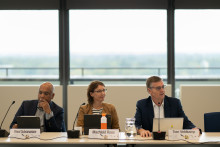The UT wants to record a deficit of no more than 7.5 million euros in 2024. But that limit has almost been reached, according to the figures from MARAP-4, the management report with data up to and including April. The UT already has a shortfall of 7.4 million euros.
Three faculties are mainly causing the provisional red figures. The Faculty of Science & Technology budgeted a deficit of 2.2 million euros, but is heading for a deficit of almost 7 million euros. ITC expected to be down 3.1 million euros, but that is heading towards minus 3.6 million euros. At the faculty of ET, a deficit of three hundred thousand euros was budgeted, but that seems to be heading towards minus 2.8 million euros. If the expected financial setback of the ET-affiliated Fraunhofer Innovation Platform is taken into account, the total deficit of the faculty is approaching 4 million euros.
However, the faculties EEMCS and BMS expect to record a positive result. BMS budgeted a deficit of almost two tonnes, but expects a 'plus' of one ton. EEMCS calculated a surplus of almost 1.6 million and expects that about five tons of that will remain.
Reducing personnel costs
Whether they are writing red or black figures, all five faculties say they have difficulty reducing personnel costs. ET and S&T do not expect to meet their staff cutback targets, EEMCS is incurring 1.5 million euros in extra costs due to temporary staff and the deployment of more student assistants. BMS and ITC also cite employee turnover as a cause of financial setbacks. For example, BMS writes that the austerity target cannot be fully achieved with natural attrition, not filling vacancies or extending contracts.
What is also a factor for the UT-wide red figures at the moment is the income from second and third money flows. The UT has set a target of 133 million euros in external revenue, but this is expected to be around 125 million euros. A difference of 7.8 million euros, which, according to the report, is mainly due to the postponement of the start of projects.
For the time being, the support services are on better track in terms of financial management, according to the report. Practically all services write positive results. Dissonant is Marketing & Communication, with a deficit of 6.5 tonnes. The service departments are also more successful than the faculties in reducing their personnel costs, according to the report.
Minimum number of students per programme
The report also makes it more concrete in which ways the UT wants to cut costs in the coming years. Of the twenty or so 'building blocks' mentioned earlier, the 'big four' are highlighted. They are going to be quite a challenge. For example, the UT wants to organise its education differently. It is not yet clear how, but it does say: 'Our students receive fifty percent more guidance than they would receive in Eindhoven or Delft. That's not sustainable.'
Another educational objective is to increase the intake. A specific rule of thumb is mentioned: every bachelor's programme must have at least fifty students per year, every master's 25. More research funding also needs to be secured: 'We need a university-wide culture change to focus more on obtaining the right external funding', the MARAP states.
In addition, there is a concrete cost-cutting target to reduce support staff. 'Corrected for size, we have 15 to 19% more OBP than TU/e and Delft. It is difficult to explain these differences to an outsider', the report states. It was previously announced that the UT wants to reduce support staff by 150 FTEs over the next four years.







